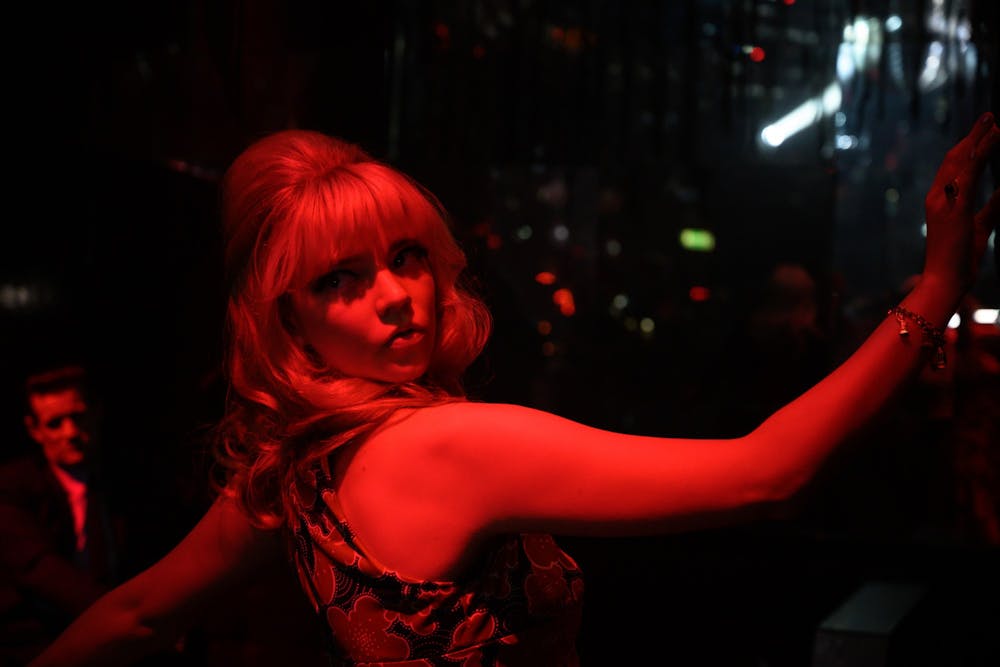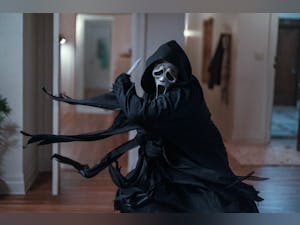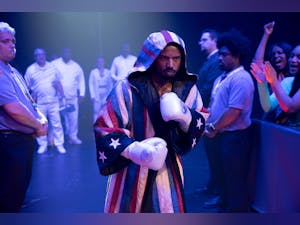From: Silver Screen
REVIEW: ‘Last Night in Soho’ is a stylish yet flawed psychological thriller

From esteemed director Edgar Wright (“Baby Driver” and “Scott Pilgrim vs. the World”), “Last Night in Soho” is a whimsical psychological thriller tinged with horror and uniquely criticizes the dangers of toxic masculinity.
Eloise “Ellie” Turner (Thomasin McKenzie) is a typical small town girl who aims to rise to the top of the fashion world as a designer. Evidently it runs in the family; Ellie’s mother had the same goal. We see Ellie catch fleeting glimpses of her mother in her bedroom mirror, revealing her sixth sense to the audience. She’s accepted into a fashion school in London, her excitement immediately palpable. After arriving at her dorm, Ellie soon discovers that she’s a small fish in a huge pond, and no one makes this more apparent than her vicious and cunning roommate Jocasta (Synnøve Karlsen).
In an effort to ease the pressure, Ellie moves to a small apartment leased by a pleasant elderly woman, Ms. Collins (Diana Rigg). That evening, as she falls asleep, Ellie is transported into the bright lights of 1960s Soho. She suddenly becomes the polished and stunning Sandie (Anya Taylor-Joy), a young woman with dreams of becoming a singer. Every night, Ellie matches Sandie’s steps in her dreams, watching as Sandie becomes enamored with the charming nightclub manager Jack (Matt Smith). These dreams steadily contort into darker realities and a gilded fantasy morphs into an unsettling look at sexual violence that bleeds into Ellie’s daytime life.
Wright’s venture into the psychological thriller genre results in a compelling and visually stunning film that stands out from other cut-and-dry slashers. “Last Night in Soho” addresses a rampant modern problem, sexual predation, through a disturbing lens of cold-sweat nightmares. Wright’s utilization of symbolism is by far the most well-executed aspect of the film. His use of mirrors and reflections help to psychologically bond Ellie to Sandie. Sandie’s life overlaps with Ellie’s, beginning with Ellie’s attempts to imitate the singer’s style and soon evolving into something far more sinister.
A celebration of 1960s London, “Last Night in Soho” shines in the costume and visuals department. Wright hits the nail on the head when it comes to the ambience of the era’s more lavish scene, from glowing nightclubs to dimly-lit bedrooms. It’s no wonder that Ellie takes inspiration from Sandie in her day-to-day life, even going so far as to dye her hair the same platinum blonde.
Another star of this film is its soundtrack. This is unsurprising considering Wright’s previous films like “Baby Driver,” but the eerie spin on classic tracks of the 60s adds a whole new layer of tension. Taylor-Joy’s cover of “You’re My World” and downtempo rendition of “Downtown” give scenes a sinister twist where the original versions would establish a completely different mood. Ellie’s obsession with older music keeps the soundtrack rooted mostly in the sixties, with a few modern songs scattered throughout the scenes depicting college life.
Although “Last Night in Soho” has its strengths, it has some pretty glaring weaknesses. The transition between Ellie’s life in the modern day and her dreams of Soho are often janky, especially in tone. When the audience is fully engaged with a tense dream sequence, the film will abruptly shift to the clumsy romance between Ellie and her kindhearted classmate, John (Michael Ajao). The reasoning for their initial bond is heavy-handed: both of them feel out of place, Ellie as a small town weirdo and John as a Black man. It’s a clumsy and uncomfortable parallel.
Smith and Taylor-Joy shine in their roles, but Ellie is by far the most aggravating character in the film. Her overly-positive attitude and stereotypical “small town, big dreams” character type gets old quickly. Some of the only development we see from her is her descent into madness. One of the most well-executed characters is Jocasta. Even her side-eye conveys a multitude of emotions ranging from jealousy to insecurity. Unfortunately, we don’t see much of her outside of her confrontations with Ellie.
Each modern day scene seems far less interesting than the dream sequences. It seems like every subplot is awkwardly shoved into Ellie’s “normal” life, while the real plot of the film takes place in her dreams. Anything in the modern day that doesn’t somehow trace back to Ellie’s dreams tends to fall flat. Although the main plot eventually merges with modern Soho for the final act, most of the twists are fairly predictable to the average audience member.
“Last Night in Soho” is a gilded film. It has a surface-level extravagance to attract both typical fans of Edgar Wright and thriller fans. The ghost story portrayed in glamorous dream sequences of 1960s Soho captures your attention quickly. However, the lack of dimensions in its main characters and tonal indecisiveness gives “Last Night in Soho” a glaring limp.
“Last Night in Soho” was released today in theaters.




